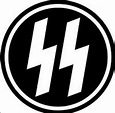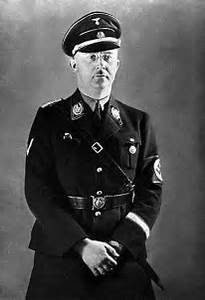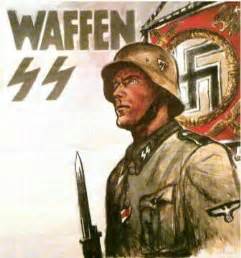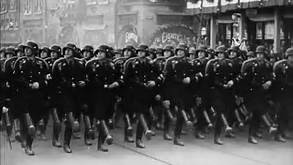The SchutzStaffel (protective squadron) had its origins in the SturmAbteilung (SA), a paramilitary organization formed to protect Nazi leaders.
The SA (“storm troopers” or “brownshirts”) was disempowered in 1934 when Hitler felt that they were too independent and not totally loyal to him. The SA’s leadership was killed or arrested by SS troops in a coup known as “The Night of The Long Knives.”
At the time, the SS was a small branch of the SA and tasked with protection of Hitler personally. They reported to Reichsfuhrer Heinrich Himmler, the #2 Nazi in the Reich. With the demise of the SA, the SS was transformed and greatly expanded by Himmler.
Himmler reorganized the SS into three divisions: The Allgemeine SS, concerned with politics, racial policies and administration; The Totenkopf SS (“Death’s Head”), which administered the death camps; and the Waffen (armed) SS, an elite combat formation that would eventually fight alongside the Wehrmacht-Heer (German Army).
The SS had its own rank structure, insignia and uniforms. It stressed loyalty and obedience to the Reich and Hitler. Its members took an oath to that effect. From its inception, the distinctive black uniformed SS was considered an elite unit.
Its officers must be German, of pure Aryan blood traceable back to 1750. Other ranks had to prove pure Aryan ancestry to 1800. There could be no evidence of Jews in the family tree. As the war wore on and casualties mounted, these requirements were relaxed. Whole divisions of non-Germans were raised from other European countries.
With war looming, the division that was expanded the fastest was the Waffen SS to the consternation of the Wehrmacht-Heer (regular army). They considered the Waffen SS too political and unprofessional.
By wars’ end, the Waffen SS had fielded 28 divisions. Over 600000 men wore or had worn the its uniform. Shortly after the war began, the black uniforms were turned in and replaced with a grey-blue one.
It was considered a high honor to be accepted into their ranks. They were elite soldiers in the early stages of the war. But as the war progressed, manpower shortages required sometimes recruiting less than first-rate soldiers. Many of the atrocities attributed to the Waffen SS came from these ranks.
After the war, the SS was considered a criminal organization by the victorious Allies. Thousands of former SS members were rounded up and tried for war crimes by the Military Tribunal in Nuremberg. Most were found not guilty or there was insufficient evidence to prosecute. Some were found guilty and paid for their crimes by death or imprisonment.
Many young men who had joined the SS committed no atrocities and simply wanted to defend their country in one of the most elite combat units in the Wehrmacht-Heer.
Regrettably, these young men were led by one of the worst leadership regimes in the most cataclysmic armed conflict in human history.




